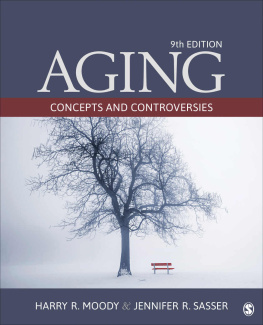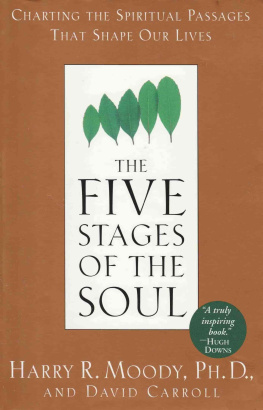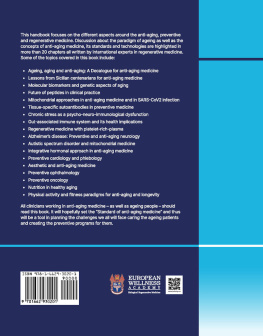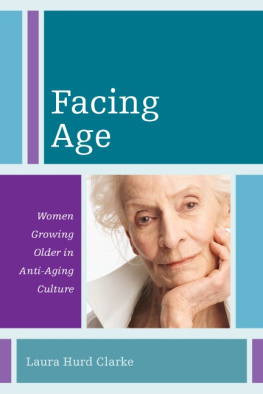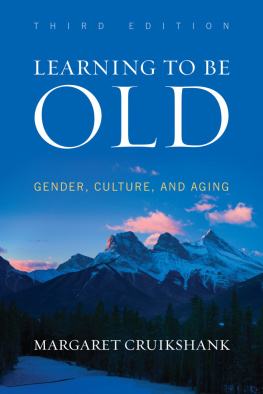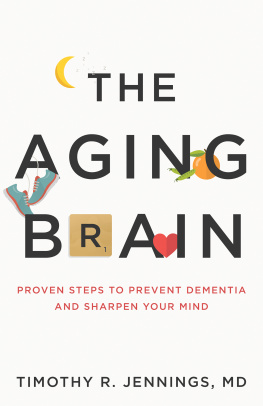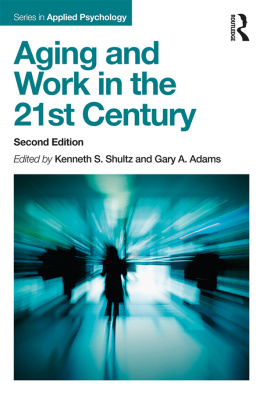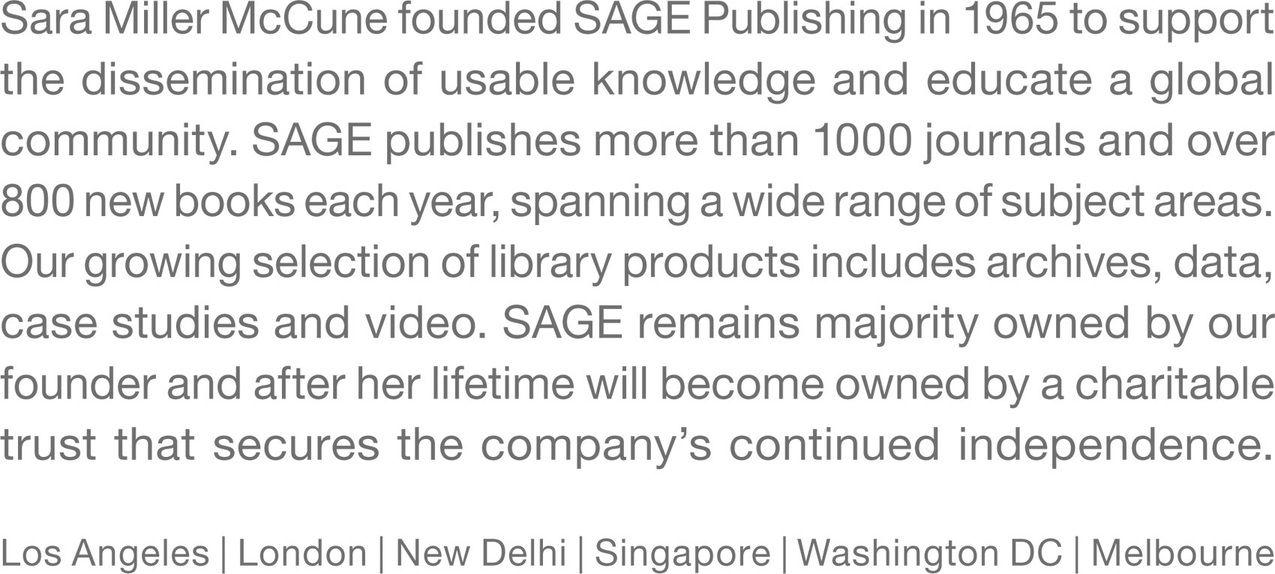Aging
9th EDITION
Aging
Concepts and Controversies
9th Edition
- Harry R. Moody
- & Jennifer R. Sasser
FOR INFORMATION:
SAGE Publications, Inc.
2455 Teller Road
Thousand Oaks, California 91320
E-mail: order@sagepub.com
SAGE Publications Ltd.
1 Olivers Yard
55 City Road
London EC1Y 1SP
United Kingdom
SAGE Publications India Pvt. Ltd.
B 1/I 1 Mohan Cooperative Industrial Area
Mathura Road, New Delhi 110 044
India
SAGE Publications Asia-Pacific Pte. Ltd.
3 Church Street
#10-04 Samsung Hub
Singapore 049483
Copyright 2018 by SAGE Publications, Inc.
All rights reserved. No part of this book may be reproduced or utilized in any form or by any means, electronic or mechanical, including photocopying, recording, or by any information storage and retrieval system, without permission in writing from the publisher.
All trademarks depicted within this book, including trademarks appearing as part of a screenshot, figure, or other image are included solely for the purpose of illustration and are the property of their respective holders. The use of the trademarks in no way indicates any relationship with, or endorsement by, the holders of said trademarks.
Printed in the United States of America
Library of Congress Cataloging-in-Publication Data
Names: Moody, Harry R., author. | Sasser, Jennifer R., author.
Title: Aging : concepts and controversies / Harry R. Moody, Jennifer R. Sasser.
Description: Ninth edition. | Thousand Oaks, California : Sage, [2018] | Includes bibliographical references and index.
Identifiers: LCCN 2016044464 | ISBN 9781506328003 (pbk. : alk. paper)
Subjects: LCSH: GerontologyUnited States. | AgingUnited States.
Classification: LCC HQ1064.U5 M665 2018 | DDC 305.260973dc23 LC record available at https://lccn.loc.gov/2016044464
This book is printed on acid-free paper.
Acquisitions Editor: Jeff Lasser
Editorial Assistant: Alexandra Croell
Production Editor: Veronica Stapleton Hooper
Copy Editor: Amy Marks
Typesetter: C&M Digitals (P) Ltd.
Proofreader: Dennis W. Webb
Indexer: Molly Hall
Cover Designer: Janet Kiesel
Marketing Manager: Kara Kindstrom
eLearning Editor: Gabrielle Piccinnini
Preface
This ninth edition of Aging: Concepts and Controversies appears at a distinctive historical moment. The oldest members of the baby boom generation are now collecting Social Security, and in the coming years, the process of population aging will accelerate dramatically. Given current demographic trends, it is likely that tens of thousands of Americans born after the year 2000 will live to see the dawn of another century, the 22nd. Students who are reading this book will spend the greatest part of their lives experiencing dramatic changes already evident in telecommunications, biotechnology, and genetics. Within recent years, global upheavals in finance, politics, and the environment have underscored dramatically the choices and risks that we all face over the life course. This ever-accelerating change will produce even more debate and controversy about how we are to live and participate in an aging society and in the 21st century.
This volume responds to public debates and new social conditions with the same unique approach that inspired earlier versions of the book. This approach is to present key ideas and content from gerontology as an opportunity for critical thinking. Memorizing facts is not enough. The approach of this text is to encourage the reader to grasp basic ideas and to reflect more deeply on issues raised by the study of aging.
As we move further into the 21st century with a population growing older not only in North America but globally, we all have a stake in developing a better understanding of the subject (Perkinson, 2013). This book intentionally focuses on issues of interest to all of us as citizens and as educated human beings, not just as potential gerontologists or professional service providers. The book takes a similarly broad view toward what aging is all about. From the opening chapter, students are encouraged to see aging not as a fixed period of life but as a process beginning at birth and extending over the entire life course. This open-ended quality of human aging is a theme woven throughout the book: from biological experiments on extending the life span to difficult choices about allocation of health care resources.
The multiple possibilities for how we might age both as individuals and as a society create complex choices that are important for all of us. New thinking is needed if we are to grasp and respond to the issues at stake. That is why the pedagogical design of this book focuses on controversies and questions, rather than on assimilating facts or coming up with a single correct view about aging or older people. The supplemental readings are selected to accentuate contrast and conflict and to stimulate faculty and students to think more deeply about what is at stake in the debates presented here. In contrast to most textbooks, this volume directs the students attention toward original sources and encourages instructors to provide the perspectives for responding to the claims made in those original texts.
The point is not to find the single right answer raised in the debates in this book. Rather, as students become engaged in the debates, they will appreciate the need for having the factual background necessary to make responsible judgments and interpretations. That is the purpose of the three major chapters, the Basic Concepts sections, around which the books controversies are organized. The data and conceptual frameworks offered in these chapters will help students make sense of the controversies, understand their origin, engage in critical thinking, and, finally, develop their own views. The introductions preceding each controversy and the questions that follow serve to reinforce the essential link between factual knowledge and interpretation at the heart of the book. This book, then, can best be seen as a textbook constructed to provide drama and compelling interest for the reader. It is structured to encourage a style of teaching and learning that goes beyond conveying facts and methods. The goal is nothing more, or less, than liberal education for gerontology.
Other, more specific features of the book reinforce this pedagogical approach. The Focus on Practice sections demonstrate the relevance of the controversies for human services work in our society. The Focus on the Future sections make us ever mindful of the accelerating pace of change in our society and its implications. The Global Perspective and Urban Legends of Aging sections provide additional opportunities for expansive and critical thinking. The appendix offers guidance for researching and writing term papers on aging, and the online resources provided as part of the books ancillary package open up access to tools for tapping the World Wide Web. Whether students reading this book go on to specialized professional work or whether they never take another course in gerontology, our aim is directed at issues of compelling human importance, now and in the future. By returning again and again to those questions of perennial human interest, we express our hope that both teachers and students will find new excitement in questions that properly concern us all, whatever our age.

